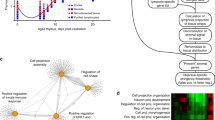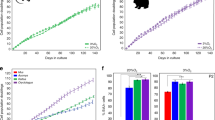Abstract
LOOSE connective tissue fibroblasts in the mouse become markedly non-motile and refractile and lose pinocytotic activity within about an hour of hydrocortisone infusion. Only minutes are required to mimic this response in culture1. These responses of fibroblasts are well correlated with the topical anti-inflammatory potency of the glucocorticoids2. Glucocorticoids inhibit the multiplication in primary cultures of rat and mouse fibroblasts and of human epithelial cells3–6. In marked contrast, they stimulate multiplication of 3T3 cells7. Some investigators regard the 3T3 cell as a prototype for the study of growth regulation in cultured fibroblasts, although this line has been identified as tumorigenic in some conditions8.
This is a preview of subscription content, access via your institution
Access options
Subscribe to this journal
Receive 51 print issues and online access
$199.00 per year
only $3.90 per issue
Buy this article
- Purchase on Springer Link
- Instant access to full article PDF
Prices may be subject to local taxes which are calculated during checkout
Similar content being viewed by others
References
Dougherty, T. F., Stevens, W., and Schneebli, G. L., in Recent Progress in Hormone Research (edit. by Greep, R .O.), 29, 287–328 (Academic, New York, 1973).
Ruhmann, A. G., and Berliner, D. L., J. invest. Dermat., 49, 123–130 (1967).
Holden, M., and Adams, L. B., Proc. Soc. exp. Biol. Med., 95, 364–368 (1957).
Ruhmann, A. G., and Berliner, D. L., Endocrinology, 76, 916–927 (1965).
Cox, R. P., and MacLeod, C. M., J. gen. Physiol., 45, 439–485 (1962).
Gray, J. G., Pratt, W. B., and Aronow, L., Biochemistry, 10, 277–284 (1971).
Thrash, C. R., and Cunningham, D. D., Nature, 242, 399–401 (1973).
Boone, C. W., Science, 188, 68–70 (1975).
Rein, O., and Rubin, H., Expl Cell Res., 49, 666–678 (1968).
Martin, G. S., Nature, 227, 1,021–1,023 (1970).
Rubin, H., and Fodge, D., in Control of Proliferation in Animal Cells (edit. by Clarkson, B., and Baserga, R.), 801–816 (Cold Spring Harbor, New York, 1974).
Rubin, H., and Koide, T., J. Cell Biol., 56, 777–786 (1973).
Tepperman, J., Metabolic and Endocrine Physiology, third ed., 136 (Year Book Publications, New York, 1973).
Rubin, H., Proc. natn. Acad. Sci. U.S.A., 72, 1676–1680 (1975).
Rubin, H., Proc. natn. Acad. Sci. U.S.A., (in the press).
Shlatz, L., and Marinetti, G. V., Science, 176, 175–177 (1972).
Sanui, H., and Pace, N., J. cell comp. Physiol., 69, 11–20 (1967).
Woods, M. W., and Vlahakis, G., J. natn. Cancer Inst., 52, 579–582 (1974).
Author information
Authors and Affiliations
Rights and permissions
About this article
Cite this article
FODGE, D., RUBIN, H. Differential effects of glucocorticoids on DNA synthesis in normal and virus-transformed chick embryo cells. Nature 257, 804–806 (1975). https://doi.org/10.1038/257804a0
Received:
Accepted:
Issue Date:
DOI: https://doi.org/10.1038/257804a0
This article is cited by
-
Teratogenicity screening in standardized chick embryo culture: Effects of dexamethasone and diphenylhydantoin
Experientia (1988)
-
Cell surface and other morphological changes accompanying growth inhibition in simian virus 40-transformed 3T3 mouse fibroblasts cells induced by glucocorticoids§
Journal of Biosciences (1987)
-
Reactivity of the liver to glucocorticoids during chemical hepatocarcinogenesis
Bulletin of Experimental Biology and Medicine (1979)
-
Specific glucocorticoid inhibition of growth promoting effects of prostaglandin F2α on 3T3 cells
Nature (1977)
-
Serum and hormonal regulation of the “resting-proliferative” transition in a variant of 3T3 mouse cells
Nature (1977)
Comments
By submitting a comment you agree to abide by our Terms and Community Guidelines. If you find something abusive or that does not comply with our terms or guidelines please flag it as inappropriate.



